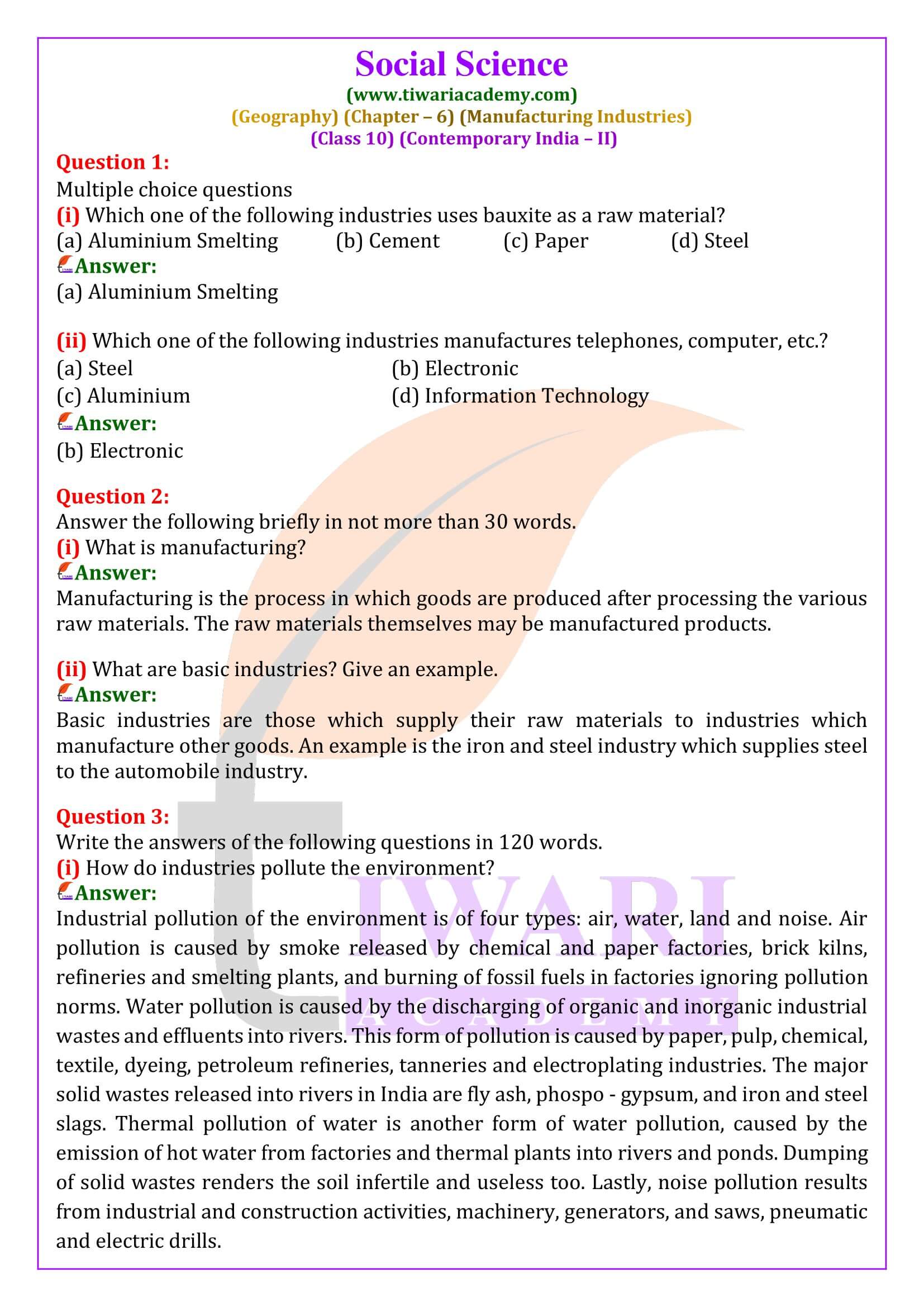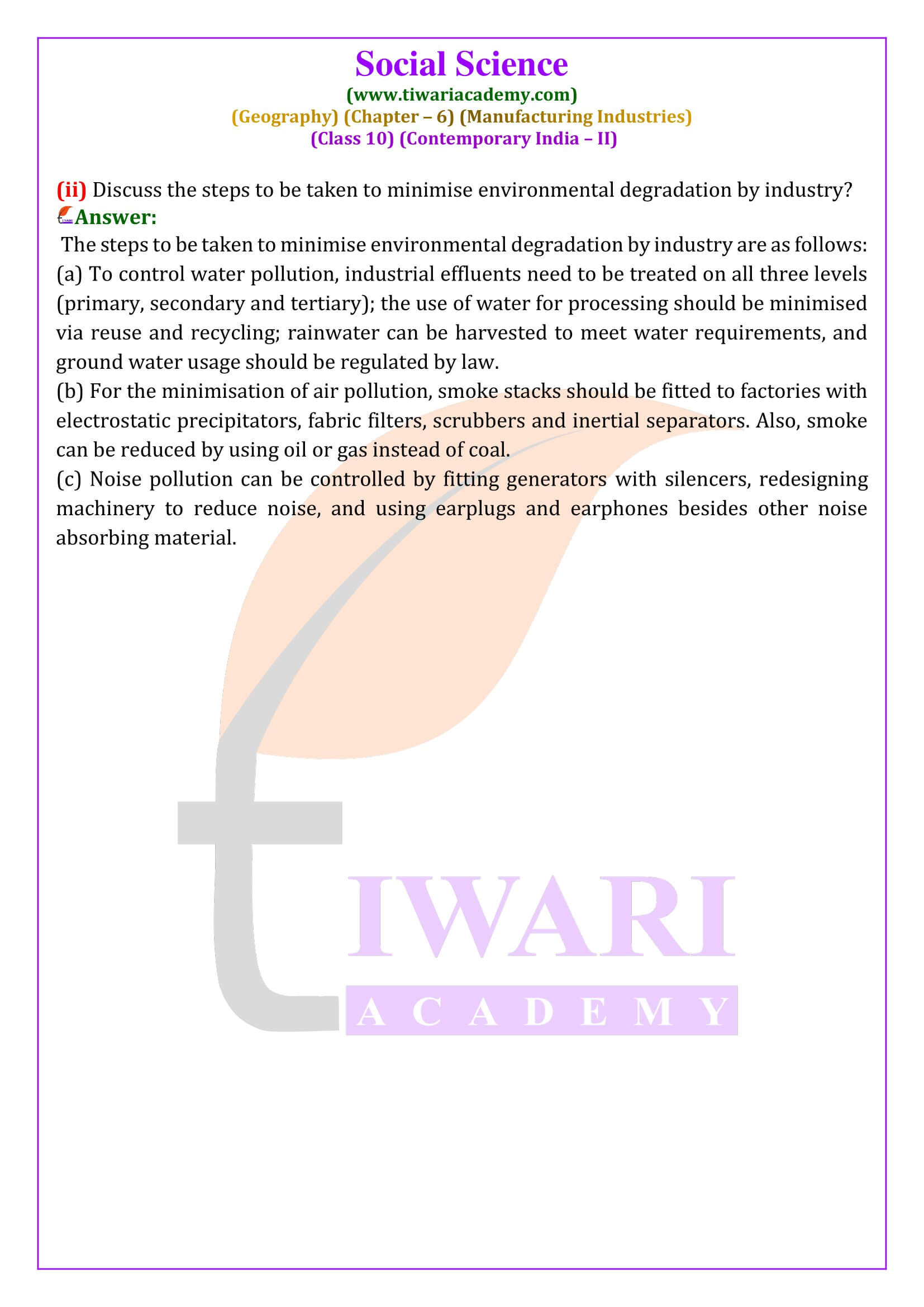NCERT Solutions for Class 10 Geography Chapter 6 Manufacturing Industries in English and Hindi Medium. NCERT Books and Offline apps are updated according to new CBSE Syllabus for academic session 2024-25. We are here to help you without any charge or conditions. Our only aim is to help the scholars with any personal benefits.
NCERT Solutions for Class 10 Geography Chapter 6 in PDF
| Class: | 10 |
| Subject: | Social Science – Geography |
| Chapter 6: | Manufacturing Industries |
| Academic Year: | 2024-25 |
Class 10 Geography Chapter 6 Manufacturing Industries
NCERT Solutions for Class 10 Geography Chapter 6 in PDF form to free download is given here updated for new academic session 2024-25. Download Offline Study Material and Offline Apps free for use. Ask your doubts in Discussion Forum and share your knowledge with your friends and other users.
Exatra Questions Class 10 Geography Chapter 6
Which challenges are being faced by the Sugar industry in India?
The challenges are as follows:
(i) This is a seasonal and short term industry.
(ii) Sugarcane production per hectare is low.
(iii) Old machines in use. Inefficient method of production.
(iv) Need to maximize the use of baggage.
(v) Transport delay in reaching cane to factories.
What are the major problems of cotton industry?
Following are the major problems of cotton industry:
Power supply is erratic.
Machinery needs to be upgraded.
Low output of labour
Stiff competition with the synthetic fibre industry.
What are the human factors effecting the location of an industry?
The human factors effecting the location of an industry are as follows:
(i) Labour
(ii) Capital
(iii) Bazaar/Markets’
(iv) Services like Transport, Communication, Banking, Insurance etc.
(v) Financial advice
(vi) Government policies
(vii) Infrastructure
(viii) Entrepreneur
Why is iron and steel industry called a heavy industry?
All the raw materials, like iron-ore, coal and lime are heavy in nature. Finished products of this industry needs high cost of transport.
Which challenges are being faced by the Jute industry of India?
(i) Things from synthetic fibre are in the market.
(ii) Synthetic fibre is cheap, compare to jute.
(iii) The jute cultivation is very expensive and hard.
(iv) Stiff competition in the international market from other substitutes is a big challenge.
(v) Bangladesh is a big challenge as a competitor while Brazil, Philippines, Egypt and Thailand are other competitors.
What are Cooperative sector industries?
These are owned and operated by the producers or suppliers of raw materials, workers or both. They pool in the resources and share the profits or losses proportionately such as the sugar industry in Maharashtra, the coir industry in Kerala.
What are the methods to make Indian industries up to the International standards?
The methods to make Indian industries up to the International standards:
(i) Political will power and a stable Government.
(ii) Modern techniques and machines.
(iii) Increasing energy supply.
(iv) Best working facilities to the workers/labours and improvement in their production ability.
(v) Increasing standards of production and international trade treaties.
(vi) Making law and order better in the nation and abolishment of unnecessary labour laws.
Why most of the jute mills are mainly located in West Bengal?
(i) The West Bengal is the largest producer of Jute in India.
(ii) Abundant and inexpensive water from the Hugli river for processing raw jute.
(iii) Cheap labour from West Bengal, Bihar, Orissa and Uttar Pradesh
(iv) Supported by a good network of railways, roadways and waterways to facilitate movement of raw material to the mills.
(v) Inexpensive (Cheap) water transport and Kolkata port for export of jute goods.
(vi) Being a large urban centre Kolkata provides banking, insurance and other facilities.
Important Terms of Class 10 Geography Chapter 6
Industry: The expended form of manufacturing.
Cottage Industry: With the help of small tools and involving family members as khadi, handicrafts etc.
Agro based Industries: Which changes agricultural products into industrial products.
Heavy industries: The industries which uses heavy and more space occupying raw material like iron and steel, sugar, cement etc.
Small scale industries: Industries which can be started with small amount of capital and with a few labours.
Joint sector industries: Which are jointly run by the state and individuals or a group of individuals, e.g. Oil India Ltd.
Private sector industries: Owned and operated by individuals or a group of individuals, e.g. Dabur, Bajaj etc.
Foreign Exchange: The exchange of a country’s currency to another state.
Mineral based industries: Which use minerals as their raw material. Such as machine tools, cement, iron and steel etc.
One Mark Questions with Answers
1. Enlist the factors influence the location of industries?
2. When and where the first successful cotton industry was established in India?
3. What is manufacturing?
4. Name the electronic capital of India?
5. What is the importance of manufacturing industries?
6. Which iron and steel plant of India is established with the German collaboration?
7. When and where the first cement industry was established in India?
8. In which industry lime stone is used as a raw material?
9. Which is the largest producer of Jute in the world?
10. Which agency provide steel for public sector in market?
Answers of 1 Mark Questions
1. Availability of raw material, labour, capital, market, sources of power, financial institution etc.
2. In Mumbai 1854.
3. Production of goods in large quantities after processing from raw materials to more valuable products is called manufacturing.
4. Bengaluru
5. By the development and competitiveness of manufacturing industries the agricultural production increases and trade-commerce get support and efficiency.
6. Rourkela(Orissa).
7. In Chennai 1904.
8. Cement industry.
9. Bangladesh.
10. Steel Authority of India Limited(SAIL)
Important Questions on Class 10 Geography Chapter 6
What is manufacturing?
Manufacturing is the process in which goods are produced after processing the various raw materials. The raw materials themselves may be manufactured products.
Name any three physical factors for the location of the industry.
Physical factors essential in deciding the location of an industry are − availability of raw materials, availability of capital and the proximity to the market.
Name any three human factors for the location of an industry.
Human factors essential in deciding the location of an industry are − availability of cheap labour, availability of services such as consultants and financial advice, and resources for maintaining labour.
What are basic industries? Give an example.
Basic industries are those which supply their raw materials to industries which manufacture other goods. An example is the iron and steel industry which supplies steel to the automobile industry.
Name the important raw materials used in the manufacturing of cement?
The important raw materials used in the manufacturing of cement are: limestone, silica, alumina and gypsum. Apart from these, coal, electric power and rail transportation are also needed.
How are integrated steel plants different from mini steel plants? What problems does the industry face? What recent developments have led to a rise in the production capacity?
Integrated steel plants are different from mini steel plants in many aspects. An integrated steel plant is large and handles everything in one complex—from integrating raw materials to steel making, rolling and shaping. On the other hand, a mini steel plant is smaller, has electric furnaces, uses steel scrap and sponge iron, and has re-rollers that use steel ingots as well. It produces mild and alloy steel of given specifications. The problems faced by this industry are: (a) high production costs and limited availability of coking coal; (b) lower productivity of labour; (c) irregular supply of energy; and (d) poor infrastructure. Recent developments that have led to a rise in the production capacity of this industry are liberalisation and Foreign Direct Investment, with help from private entrepreneurs.
How do industries pollute the environment?
Industrial pollution of the environment is of four types: air, water, land and noise. Air pollution is caused by smoke released by chemical and paper factories, brick kilns, refineries and smelting plants, and burning of fossil fuels in factories ignoring pollution norms. Water pollution is caused by the discharging of organic and inorganic industrial wastes and effluents into rivers. This form of pollution is caused by paper, pulp, chemical, textile, dyeing, petroleum refineries, tanneries and electroplating industries. The major solid wastes released into rivers in India are fly ash, phospo – gypsum, and iron and steel slags. Thermal pollution of water is another form of water pollution, caused by the emission of hot water from factories and thermal plants into rivers and ponds. Dumping of solid wastes renders the soil infertile and useless too. Lastly, noise pollution results from industrial and construction activities, machinery, generators, and saws, pneumatic and electric drills.
Discuss the steps to be taken to minimise environmental degradation by industry?
The steps to be taken to minimise environmental degradation by industry are as follows: (a) To control water pollution, industrial effluents need to be treated on all three levels (primary, secondary and tertiary); the use of water for processing should be minimised via reuse and recycling; rainwater can be harvested to meet water requirements, and ground water usage should be regulated by law. (b) For the minimisation of air pollution, smoke stacks should be fitted to factories with electrostatic precipitators, fabric filters, scrubbers and inertial separators. Also, smoke can be reduced by using oil or gas instead of coal. (c) Noise pollution can be controlled by fitting generators with silencers, redesigning machinery to reduce noise, and using earplugs and earphones besides other noise absorbing material.






